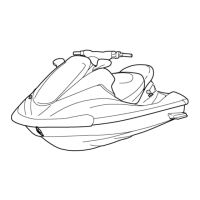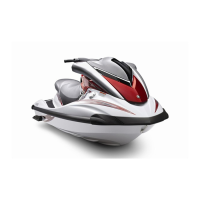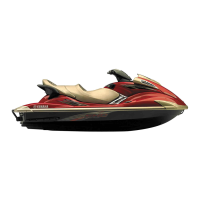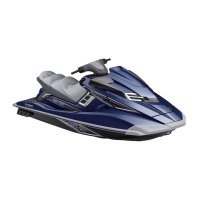Do you have a question about the Yamaha WaveRunner FX HO 2016 and is the answer not in the manual?
Details about PRI-ID, CIN, and engine serial numbers for watercraft identification.
Location and significance of the manufactured date label on the engine cylinder head.
Information regarding the watercraft's compliance with European Parliament directives.
Explains the builder's plate affixed to the craft and its directive compliance.
Instructions to read important labels before using the watercraft.
Guidance on warning labels and contacting a dealer for replacements if damaged or missing.
Information on additional labels, such as fire extinguisher and capacity markings.
Recommends minimum operator age, supervision for minors, and load capacity limits.
Provides guidelines for safe operation, scanning surroundings, and avoiding hazards.
Specifies mandatory safety equipment like PFDs and protective clothing.
Lists recommended safety items such as sound-signaling devices and towlines.
Warns about exhaust fumes, hot engine parts, and magnetic interference.
Explains watercraft behavior, including jet thrust steering and off-throttle steering.
Provides safety considerations for pulling wakeboarders or water-skiers.
Emphasizes that the watercraft is a powerboat and must follow waterway regulations.
Promotes responsible operation, respect for others, and environmental care.
Defines key terms related to watercraft operation and components.
Illustrates and identifies the exterior and interior components of the watercraft.
Overview of controls and systems, including the remote control transmitter.
Explains the function and care of the remote control transmitter for security and mode settings.
Details on the security system's lock and unlock modes for preventing unauthorized use.
Instructions for using the red engine stop switch to halt the engine.
Explains the function of the engine shut-off switch and lanyard for safety.
Guidance on operating the green start switch to begin engine operation.
Describes how the throttle lever controls engine speed and returns to idle.
Explains the RiDE lever's function for reverse, deceleration, and neutral.
Details on how turning the handlebars controls the watercraft's direction.
Instructions for adjusting the handlebar position using the tilt lever.
Explains the function of the cooling water pilot outlet for system checks.
Describes the water separator's role in preventing water in the fuel tank.
Overview of core operational functions.
Details on operating the shift system for forward, neutral, and reverse.
Explains how to adjust the jet thrust nozzle angle for trim control.
Information on different operational modes available for the watercraft.
Details on activating and deactivating the Low RPM Mode for reduced speed.
Instructions for activating and deactivating the no-wake mode for low-speed operation.
Guidance on using cruise assist to maintain a set engine speed.
Overview of the multifunction information center's display and operation.
Describes the dual function analog meter for speed and engine RPM.
Explains the information display showing various operating conditions.
Details on the digital speedometer and switching display units (km/h or mph).
Explains the dual function meter for tracking engine hours and battery voltage.
Describes the fuel level indicator and its segments.
Information on the fuel level warning indicator and buzzer.
Details on the oil pressure warning system and necessary actions.
Explains the engine overheat warning indicator and what to do if activated.
Information on the check engine warning indicator and potential causes.
Describes various information shown on the multifunction display.
Explains the shift indicator showing forward, neutral, and reverse positions.
Details on the trim indicator showing the jet thrust nozzle angle.
Shows how to switch between different display modes for watercraft information.
Overview of the watercraft's equipment.
Instructions for removing and installing the front and rear seats.
Describes the purpose and safety warnings for the handgrip.
Explains the use of the reboarding grip for boarding from the water.
Details on using the reboarding step to assist with boarding from water.
Purpose of the bow eye for towing, mooring, and transport.
Function of the stern eyes for attaching ropes during transport or mooring.
Use of the cleat for attaching ski ropes and safety warnings.
Instructions for using pull-up cleats for mooring and safety warnings.
Overview of the watercraft's storage compartments.
Details on accessing and capacity of the bow storage compartment.
Instructions for opening, closing, and draining the glove compartment.
Information on opening, closing, and capacity of the stern storage compartment.
Location and usage precautions for built-in and removable beverage holders.
Information on watertight compartments and their security.
Instructions for using the fire extinguisher holder and cover in the bow compartment.
Guidance on recommended fuel types, octane ratings, and refueling procedures.
Specifies recommended engine oil types, grades, and checking procedures.
Instructions for draining bilge water on land and on water.
Guidelines for securely tying down the watercraft when transporting on a trailer.
Essential procedures for breaking in the engine to ensure longevity and performance.
A comprehensive checklist for pre-operation inspections before using the watercraft.
Specific checks to perform before launching the watercraft.
Checks to conduct after the watercraft is launched and the engine is running.
General advice on becoming familiar with controls before operation.
Emphasizes practicing basic techniques and familiarizing oneself with operation.
Recommends performing pre-operation checks and learning in a safe environment.
Describes the correct operator and passenger riding positions for stability.
Guidance on safely launching the watercraft from land or a trailer.
Step-by-step instructions for starting the engine while the watercraft is in water.
Procedure for leaving the watercraft to prevent unauthorized use.
Basic operation of moving forward using the throttle lever.
Explains how throttle and handlebar input affect turning performance.
Details on how the watercraft slows down and stops using water resistance.
Instructions for operating in reverse and neutral modes.
Safety precautions and procedures for boarding the watercraft from the water.
Steps for a single person to board the watercraft from the water.
Procedure for boarding the watercraft with one or more passengers.
Guidance on starting off safely, emphasizing collision avoidance.
Steps for starting off after launching from a trailer.
Procedure for boarding and starting off when docked.
Instructions for righting a capsized watercraft safely.
Procedures for safely beaching and docking the watercraft.
Advice on operating in areas with weed growth to prevent clogging.
Procedure for discharging residual water from cooling passages.
General advice on cleaning and storing the watercraft after use.
Instructions for flushing cooling passages to prevent clogging.
Detailed steps for cleaning the hull, deck, engine, and components.
Guidance on battery maintenance, removal, checking, and storage.
Preventive maintenance procedures for storing the watercraft for extended periods.
Instructions for lubricating moving parts and cables with marine grease.
Steps for applying rust inhibitor to metallic parts of the watercraft.
Importance of periodic checks and lubrication for safe and efficient operation.
Information about the included tool kit and its storage.
Step-by-step guide for removing and reinstalling the engine cover.
Schedule of recommended periodic maintenance tasks and intervals.
Recommendations and warnings regarding engine oil and filter changes.
A chart to diagnose and remedy common watercraft problems.
Steps to take in critical situations, including cleaning jet intake and impeller.
Procedure for removing debris from the jet intake and impeller area.
How to manually raise the reverse gate if it remains lowered due to system malfunction.
Instructions for starting the engine using a booster battery with jumper cables.
Guide to locating, replacing, and identifying watercraft fuses.
Procedures and safety precautions for towing an inoperative watercraft.
Steps for handling a watercraft that has been submerged or flooded.
Details about PRI-ID, CIN, and engine serial numbers for watercraft identification.
Location and significance of the manufactured date label on the engine cylinder head.
Information regarding the watercraft's compliance with European Parliament directives.
Explains the builder's plate affixed to the craft and its directive compliance.
Instructions to read important labels before using the watercraft.
Guidance on warning labels and contacting a dealer for replacements if damaged or missing.
Information on additional labels, such as fire extinguisher and capacity markings.
Recommends minimum operator age, supervision for minors, and load capacity limits.
Provides guidelines for safe operation, scanning surroundings, and avoiding hazards.
Specifies mandatory safety equipment like PFDs and protective clothing.
Lists recommended safety items such as sound-signaling devices and towlines.
Warns about exhaust fumes, hot engine parts, and magnetic interference.
Explains watercraft behavior, including jet thrust steering and off-throttle steering.
Provides safety considerations for pulling wakeboarders or water-skiers.
Emphasizes that the watercraft is a powerboat and must follow waterway regulations.
Promotes responsible operation, respect for others, and environmental care.
Defines key terms related to watercraft operation and components.
Illustrates and identifies the exterior and interior components of the watercraft.
Overview of controls and systems, including the remote control transmitter.
Explains the function and care of the remote control transmitter for security and mode settings.
Details on the security system's lock and unlock modes for preventing unauthorized use.
Instructions for using the red engine stop switch to halt the engine.
Explains the function of the engine shut-off switch and lanyard for safety.
Guidance on operating the green start switch to begin engine operation.
Describes how the throttle lever controls engine speed and returns to idle.
Explains the RiDE lever's function for reverse, deceleration, and neutral.
Details on how turning the handlebars controls the watercraft's direction.
Instructions for adjusting the handlebar position using the tilt lever.
Explains the function of the cooling water pilot outlet for system checks.
Describes the water separator's role in preventing water in the fuel tank.
Overview of core operational functions.
Details on operating the shift system for forward, neutral, and reverse.
Explains how to adjust the jet thrust nozzle angle for trim control.
Information on different operational modes available for the watercraft.
Details on activating and deactivating the Low RPM Mode for reduced speed.
Instructions for activating and deactivating the no-wake mode for low-speed operation.
Guidance on using cruise assist to maintain a set engine speed.
Overview of the multifunction information center's display and operation.
Describes the dual function analog meter for speed and engine RPM.
Explains the information display showing various operating conditions.
Details on the digital speedometer and switching display units (km/h or mph).
Explains the dual function meter for tracking engine hours and battery voltage.
Describes the fuel level indicator and its segments.
Information on the fuel level warning indicator and buzzer.
Details on the oil pressure warning system and necessary actions.
Explains the engine overheat warning indicator and what to do if activated.
Information on the check engine warning indicator and potential causes.
Describes various information shown on the multifunction display.
Explains the shift indicator showing forward, neutral, and reverse positions.
Details on the trim indicator showing the jet thrust nozzle angle.
Shows how to switch between different display modes for watercraft information.
Overview of the watercraft's equipment.
Instructions for removing and installing the front and rear seats.
Describes the purpose and safety warnings for the handgrip.
Explains the use of the reboarding grip for boarding from the water.
Details on using the reboarding step to assist with boarding from water.
Purpose of the bow eye for towing, mooring, and transport.
Function of the stern eyes for attaching ropes during transport or mooring.
Use of the cleat for attaching ski ropes and safety warnings.
Instructions for using pull-up cleats for mooring and safety warnings.
Overview of the watercraft's storage compartments.
Details on accessing and capacity of the bow storage compartment.
Instructions for opening, closing, and draining the glove compartment.
Information on opening, closing, and capacity of the stern storage compartment.
Location and usage precautions for built-in and removable beverage holders.
Information on watertight compartments and their security.
Instructions for using the fire extinguisher holder and cover in the bow compartment.
Guidance on recommended fuel types, octane ratings, and refueling procedures.
Specifies recommended engine oil types, grades, and checking procedures.
Instructions for draining bilge water on land and on water.
Guidelines for securely tying down the watercraft when transporting on a trailer.
Essential procedures for breaking in the engine to ensure longevity and performance.
A comprehensive checklist for pre-operation inspections before using the watercraft.
Specific checks to perform before launching the watercraft.
Checks to conduct after the watercraft is launched and the engine is running.
General advice on becoming familiar with controls before operation.
Emphasizes practicing basic techniques and familiarizing oneself with operation.
Recommends performing pre-operation checks and learning in a safe environment.
Describes the correct operator and passenger riding positions for stability.
Guidance on safely launching the watercraft from land or a trailer.
Step-by-step instructions for starting the engine while the watercraft is in water.
Procedure for leaving the watercraft to prevent unauthorized use.
Basic operation of moving forward using the throttle lever.
Explains how throttle and handlebar input affect turning performance.
Details on how the watercraft slows down and stops using water resistance.
Instructions for operating in reverse and neutral modes.
Safety precautions and procedures for boarding the watercraft from the water.
Steps for a single person to board the watercraft from the water.
Procedure for boarding the watercraft with one or more passengers.
Guidance on starting off safely, emphasizing collision avoidance.
Steps for starting off after launching from a trailer.
Procedure for boarding and starting off when docked.
Instructions for righting a capsized watercraft safely.
Procedures for safely beaching and docking the watercraft.
Advice on operating in areas with weed growth to prevent clogging.
Procedure for discharging residual water from cooling passages.
General advice on cleaning and storing the watercraft after use.
Instructions for flushing cooling passages to prevent clogging.
Detailed steps for cleaning the hull, deck, engine, and components.
Guidance on battery maintenance, removal, checking, and storage.
Preventive maintenance procedures for storing the watercraft for extended periods.
Instructions for lubricating moving parts and cables with marine grease.
Steps for applying rust inhibitor to metallic parts of the watercraft.
Importance of periodic checks and lubrication for safe and efficient operation.
Information about the included tool kit and its storage.
Step-by-step guide for removing and reinstalling the engine cover.
Schedule of recommended periodic maintenance tasks and intervals.
Recommendations and warnings regarding engine oil and filter changes.
A chart to diagnose and remedy common watercraft problems.
Steps to take in critical situations, including cleaning jet intake and impeller.
Procedure for removing debris from the jet intake and impeller area.
How to manually raise the reverse gate if it remains lowered due to system malfunction.
Instructions for starting the engine using a booster battery with jumper cables.
Guide to locating, replacing, and identifying watercraft fuses.
Procedures and safety precautions for towing an inoperative watercraft.
Steps for handling a watercraft that has been submerged or flooded.
| Displacement | 1812 cc |
|---|---|
| Compression Ratio | 11.0:1 |
| Fuel Delivery System | Electronic Fuel Injection (EFI) |
| Horsepower | 180 hp |
| Starter System | Electric |
| Lubrication System | Wet Sump |
| Engine Type | 4-stroke, 4-cylinder |
| Fuel Capacity | 18.5 gal |
| Rider Capacity | 3 persons |
| Fuel Type | Regular unleaded |
| Pump Type | 155 mm |
| Bore x Stroke | 86mm x 78mm |
| Cooling System | Water-cooled |
| Hull Material | Fiberglass |
| Color Options | Black |
| Top Speed | 65 mph |











